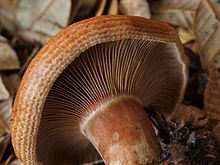| Lactarius rubrilacteus | |
|---|---|

| |
| Scientific classification | |
| Domain: | Eukaryota |
| Kingdom: | Fungi |
| Division: | Basidiomycota |
| Class: | Agaricomycetes |
| Order: | Russulales |
| Family: | Russulaceae |
| Genus: | Lactarius |
| Species: | L. rubrilacteus
|
| Binomial name | |
| Lactarius rubrilacteus | |
| Lactarius rubrilacteus | |
|---|---|
| Gills on hymenium | |
| Cap is convex | |
| Hymenium is decurrent | |
| Stipe is bare | |
| Spore print is cream | |
| Ecology is mycorrhizal | |
| Edibility is edible | |
Lactarius rubrilacteus is a species of mushroom of the genus Lactarius.[1] It is also known as the bleeding milkcap, as is at least one other member of the genus, Lactarius sanguifluus.[2]
Description[edit]
The mushroom can have either a bluish green or an orangy brown hue, with creamy white or yellow spores that are ellipsoid in shape.[3][4] Greenish colors are more common to old, damaged or unexpanded specimens.[5] The cap of the mushroom is convex and sometimes shield-shaped and 6–12 cm (2+1⁄4–4+3⁄4 in) across, reaching a height of 5–15 cm (2–6 in) tall. The cap also has quite an underfolded margin and a depressive disk.[3]
Lactarius rubrilacteus has many laticifers which appear as a white network across the surface of the mushroom.[4] When sliced or cut, the mushroom flesh will typically release a dark red to purple latex or milky substance.[1] The flesh itself will lose colour when damaged, and is usually granular or brittle to the touch.[3] The stem is quite thin, being only several centimetres in any dimension, and is of an average size and shape for a mushroom. The fungus itself exudes a slight odour that is faintly aromatic.[3] This mushroom is edible.[6] Commonly found with a small blue or green mushroom attached at the base. Bruises green.
Similar species[edit]
Lactarius deliciosus is a related species, but its cap differs in appearance.[5] L. sanguifluus is also similar.[5]
Distribution and habitat[edit]
The mushroom is primarily found in parts of western North America, growing in forests and on the ground. The mushroom usually finds cover under conifer trees, mainly Douglas fir.[3] It is widely distributed in these areas between the months of June and October.[3]
Chemical reactivity[edit]
- Potassium hydroxide: When the mushroom comes in contact with potassium hydroxide, most of the mushroom, including the mantle and ectomycorrhizae, loses its bluish hue and becomes a dull brown.[4]
- Melzer's reagent: Hardly any visible reaction on any part of the mushroom occurs. This particular mushroom appears to have little reactivity to Melzer's Reagent.[4]
- Sulfovanillin: Most of the mushroom becomes a reddish-brown color, but the oldest roots of the fungi stay unaltered by contact with sulfovanillin.[4]
See also[edit]
References[edit]
- ^ a b Robert Rich. "Lactarius rubrilacteus". Retrieved 18 April 2007.
- ^ Thiers, Harry D.; Arora, David (September 1980). "Mushrooms Demystified". Mycologia. 72 (5): 1054. doi:10.2307/3759750. ISSN 0027-5514.
- ^ a b c d e f "Lactarius rubrilacteus". RogersMushrooms.com. Archived from the original on 27 September 2007. Retrieved 18 April 2007.
- ^ a b c d e "Lactarius rubrilacteus Hesler & Smith". British Columbia Ectomycorrhizal Research Network. Archived from the original on 26 May 2007. Retrieved 18 April 2007.
- ^ a b c Trudell, Steve; Ammirati, Joe (2009). Mushrooms of the Pacific Northwest. Timber Press Field Guides. Portland, OR: Timber Press. p. 60. ISBN 978-0-88192-935-5.
- ^ Miller Jr., Orson K.; Miller, Hope H. (2006). North American Mushrooms: A Field Guide to Edible and Inedible Fungi. Guilford, CN: FalconGuide. p. 89. ISBN 978-0-7627-3109-1.